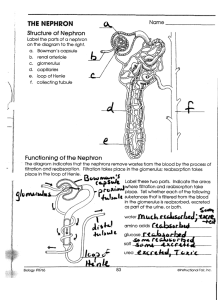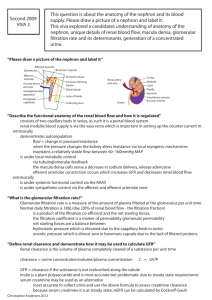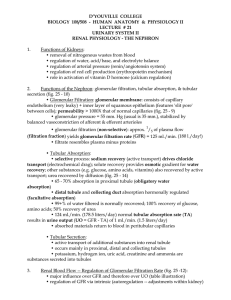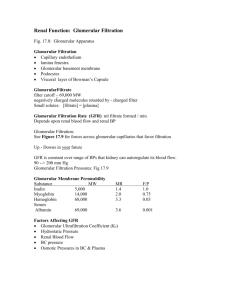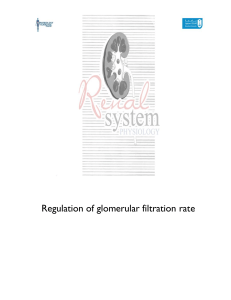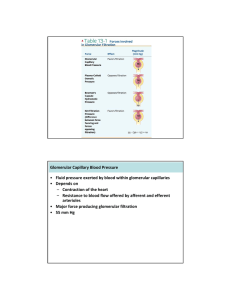Practicals-7; GFR
advertisement
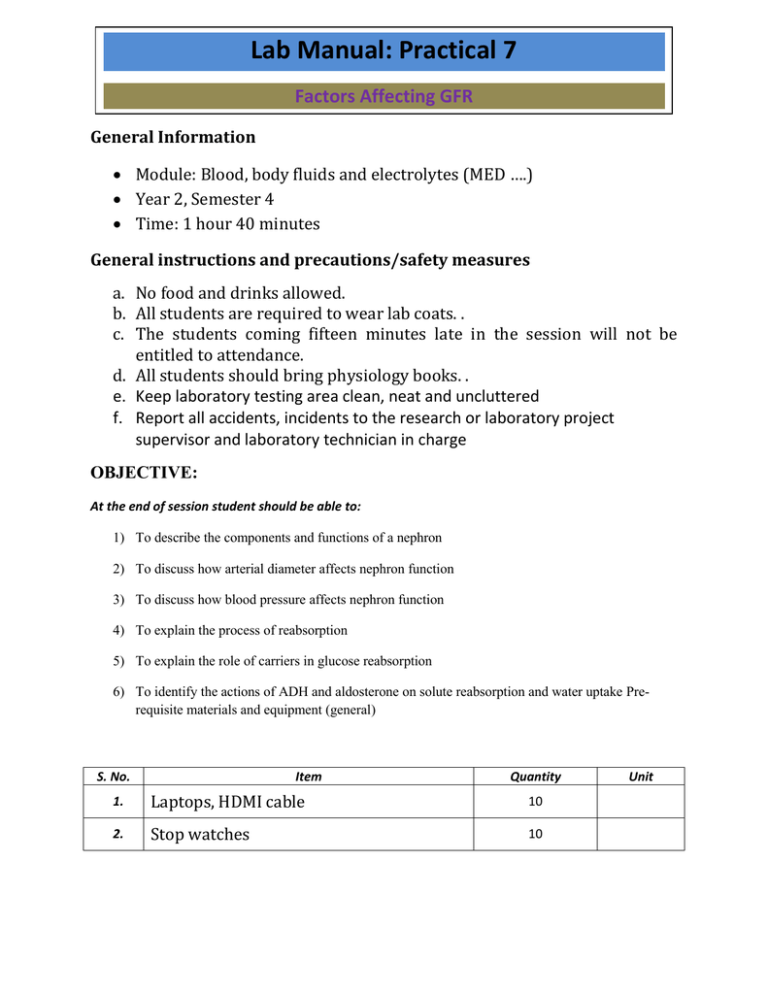
Lab Manual: Practical 7 Factors Affecting GFR General Information Module: Blood, body fluids and electrolytes (MED ….) Year 2, Semester 4 Time: 1 hour 40 minutes General instructions and precautions/safety measures a. No food and drinks allowed. b. All students are required to wear lab coats. . c. The students coming fifteen minutes late in the session will not be entitled to attendance. d. All students should bring physiology books. . e. Keep laboratory testing area clean, neat and uncluttered f. Report all accidents, incidents to the research or laboratory project supervisor and laboratory technician in charge OBJECTIVE: At the end of session student should be able to: 1) To describe the components and functions of a nephron 2) To discuss how arterial diameter affects nephron function 3) To discuss how blood pressure affects nephron function 4) To explain the process of reabsorption 5) To explain the role of carriers in glucose reabsorption 6) To identify the actions of ADH and aldosterone on solute reabsorption and water uptake Prerequisite materials and equipment (general) S. No. Item Quantity 1. Laptops, HDMI cable 10 2. Stop watches 10 Unit Activity specific materials and equipment S. No. 1. Item PhysEX 8 software Quantity Unit 10 Time plan of the activity session Time plan Settling time. Discussing session objectives. Brief demonstration by content expert. Showing video. Practicing the experiment using PHYSex8 software Evaluating session by asking questions, peer teaching by students and verbal feedback Dividing students in further small groups and each group will perform and summarize the session 5 minutes 10 minutes 20 minutes 15 minutes 25 minutes 10 minutes 15 minutes Methods The student will start the session under supervision of the tutor. OPEN THE SOFTWARE Enter into the program Select Renal system physiology from the content Then press GO button Then from the MENU choose the activities Perform the activity GFR and Urine formation to achieve the given learning objectives according to the guidelines 1) Effect of Arteriole Diameter on Glomerular Filtration. 2) Effect of Pressure on Glomerular Filtration. 3) Combined Effects. Introduction Blood enters the glomerulus from the afferent arteriole. Starling forces (hydrostatic and osmotic pressure gradients) drive protein-free plasma from the blood across the walls of the glomerular capillaries and into the Bowman’s capsule. The glomerular filtration rate is an index of kidney function. In humans, the filtration rate ranges from 80 to 140 ml/min, so that in 24 hours as much as 180 liters of plasma is filtered by glomeruli. The filtrate formed is devoid of cellular debris and is essentially protein free. The concentration of salts and organic molecules are similar to that of blood. Normal urine output is 1–1.5 liters/24 hours. The difference is reabsorbed in the body. Normally, only about 20% of the blood that enters the nephron is filtered, due to the osmotic pressure of the blood (oncotic pressure) and the hydrostatic pressure from the fluids in Bowman’s capsule. The glomerular filtration rate can be altered by changing afferent arteriole resistance, efferent arteriole pressure, or the size of the filtration surface, or by a process called renal auto-regulation. REFERENCE: Fauci, Anthony S., et al. Harrison's Principles of Internal Medicine. 17th ed. United States: McGraw-Hill Professional, 2008. Textbook of practical physiology, C.L.GHAI, jaypree brothers Medical Pub; 8th Ed (2012) Assessment/ Assignment: 1) Define glomerular filtration 2) How can the glomerular filtration rate be changed? 3) What is the effect of reducing afferent arteriole radius on filtration rate? 4) What is the effect of reducing efferent arteriole radius on filtration rate? 5) What effects would increase blood pressure have on nephron function? 6) What could cause increased blood pressure in the glomerulus? 7) How could you adjust the afferent or efferent radius to compensate for the effect of reduced blood pressure on glomerular filtration rate?
